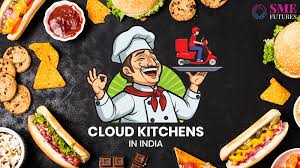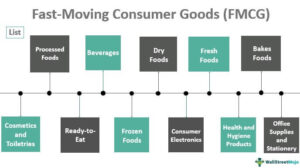How cloud kitchens are helping grow fmcg and food industry?
The revenue in the online food delivery market is expected to reach $137,596 million worldwide, by 2023.
Now think of a restaurant model that exists purely to capture this market.
According to a recent survey conducted by us, 67% of the restaurant owners would want to open a cloud kitchen as their next outlet.
As consumers shift their dining behaviour increasingly to delivery, it’s impossible for restaurants to ignore the large appetite for this new model. Even industry trends have started showing up in favour.
Cloud kitchen companies are proliferating around the world, in India from Kashmir to Kayakumari and world over from LA to Dubai to Taipei. Perhaps the single person most associated with the cloud kitchen notion is Uber founder and ultimate tech bro Travis Kalanick. After leaving Uber he launched CloudKitchens in 2016 with the idea of re-inventing the restaurant experience. And business model. All while scooping up a lot of cheap commercial real estate in the process.
There are plenty of bullish forecasts out there calling for unyielding growth in the cloud kitchen industry. One from Euromonitor calls for a trillion-dollar global cloud kitchen industry within a decade. There is no question the pandemic’s massive acceleration of the food delivery business has fueled cloud kitchens. But its premise was always based on longer-term trends. And one of its core value propositions has been to make it easier to start a restaurant.
In a recent blog post, CloudKitchens shared a graphic that lays out the decision matrix for a company trying to decide whether to go cloud or go traditional.

Cloud kitchen or the digital restaurant is the latest trend that has quickly established itself in the restaurant space as a formidable restaurant format. With the ongoing situation in the restaurant industry, extreme competition, high rentals, and rising costs, Cloud Kitchens seem like a smarter way to run the restaurant business. According to statistics, the Global Cloud Kitchen Market size is estimated to reach USD 71.4 Billion by 2027, with a CAGR of 12.0% from 2021 to 2027.

Convenience of Frozen Foods in a cloud kitchen saves time and expensive man hours. Improve ROI due to faster deliveries of orders.

How much investment is required to open a cloud kitchen?
The 6 Cloud Kitchen Business Models
The independent cloud kitchen model – Single brand, single kitchen, no storefront.
This is the original cloud kitchen model. A restaurant with no seating space and no physical store. Restaurant owners or food business entrants sidestepping high rents and real estate costs by shedding the front-of-house. This concept gained popularity with the growth of online ordering and growing consumer demand for deliveries.
Typical kitchen size – 500 – 600 sq ft.
How it works
Orders come from online sources
Kitchen only
Specialized in a cuisine
Delivery only
A mix of aggregator dependency and self-reliance for orders and deliveries
The Rebel foods (Faasos) business model – Multi-brand (cuisine), single kitchen, multiple outlets, no storefront.
The more elaborate cloud kitchens are based on data intelligence such as area wise demographics of residents, popular cuisines and hyperlocal demand-supply. The idea here is to address the demand for the most ordered cuisine (Biriyani, North-Indian, Chinese, Burgers, Pizza & Pasta – that’s really it in India) in a neighbourhood (a 5-6 km radius) with relatively lesser restaurant options that serve these dishes. This model is clever because it positions the separate brands as their own individual establishments. And having a single shared kitchen keeps operational costs low. This model closely resembles the original cloud kitchen model with no physical storefront. You could think of it as specialized cuisine based cloud restaurants, owned by the same mother brand, sharing the same kitchen.
How it works
Orders come from online sources
Single kitchen, multiple brands
Each brand specialized in a cuisine
Delivery only
A mix of aggregator dependency and self-reliance for orders and deliveries
The Freshmenu business model – Single brand, single kitchen, multiple outlets, with a storefront.
This is kind of a mashup between a takeaway restaurant and a cloud kitchen. It resembles a cloud kitchen business model for the most part, but also has a storefront. The storefront exists to allow customers to walk in and see how their food is prepared, should they ever want to. In essence, this model utilizes all the operational efficiencies of the cloud kitchen business model but also has a “real” window with customers.
Typical kitchen size – 1200 – 2000 ft
How it works
Orders come from online sources
Single kitchen, single brand
Changing menu that has a mix of seasonal dishes and bestsellers
Delivery and take away
A mix of aggregator dependency and self-reliance for orders and deliveries
The Swiggy Access business model – Aggregator owned, multi (restaurant) brand, rented co-working kitchens, no storefront.
This cloud kitchen model often called the “shell” in the food business circles, is basically an optimally located empty kitchen space with the bare minimum infrastructure – gas pipelines, drainage and ventilation systems. Established (or new) restaurant businesses rent that kitchen space, make use of Swiggy’s online ordering, delivery fleet and menu intelligence to set-up a restaurant. The restaurant brings the equipment, staff, raw materials and recipes. In simple, the restaurant does the cooking and Swiggy does the rest.
Typical kitchen size – Each kitchen is 100-500 sq ft within a larger kitchen.
How it works
Orders come from Swiggy
Single kitchen, multiple restaurant “partner” brand
The Restaurant takes care of the menu, kitchen equipment, and staff
Delivery and fulfillment, by Swiggy
The Zomato Infrastructure Services business model – Aggregator owned, multi-restaurant brand, rented kitchens, with a storefront.
One-up from the bare bones Swiggy access model, the Zomato model is based on the idea of rented kitchens but with built-in kitchen equipment and comprehensive processes. In this model, Zomato also shares its know-how on order demand management. Like the Freshmenu model, these cloud kitchens also have a storefront where customers can walk in. A mash-up between a cloud kitchen and takeaway restaurant, similar to the Freshmenu example. Powered by Zomato’s insights.
Typical kitchen size – 250-500 sq ft
How it works
Orders come from Zomato
Single kitchen, multiple restaurant “partner” brand
The Restaurant takes care of the menu
Zomato does everything else
Customers have the option of walking into physical storefronts
The Kitopi business model – Cooking and delivery fully outsourced
This is a relatively newer concept in the cloud kitchen business model mix. In this model, you can outsource everything from your call centre operations, your kitchen and delivery. Imagine a restaurant where a large majority of the kitchen prep is outsourced and gets delivered to your kitchen. Your chefs can then do the final touches and Kitopi picks it up for delivery again.
How it works
Orders come in via Kitopi owned call centre, through your own online platforms and third parties
Kitopi buys and stores your raw materials
Then “pre-prepares” the food in its centralized kitchen
Kitopi then sends over the food to your kitchen for final touches
Picks it up and delivers it to your customer

The secret sauce behind a successful restaurant is the team that works for it, with the Chef being the most critical part of the team, as they not only prepare the food but also helps in designing the menu. In an online kitchen, a minimum of five employees is required. You’d need at least two chefs, two helpers, and one housekeeper. The salary of the staff depends on their experience.
The average salary of the Chef at Commis level 1 is Rs 14000- Rs 15000, while that of helpers and other staff salary range between Rs 6000- Rs 8000 based on their work. Apart from the kitchen staff, two employees at the delivery and one at the counter for receiving online and telephonic orders are required. Here we would also like to recommend you to partner with the third-party delivery services which work on a per order basis.

Who should think of opening a cloud kitchen?

Food entrepreneurs
If you have got a unique idea and are looking for a lesser expensive way to enter the market, cloud kitchens serve the exact purpose. They require less investment as compared to a full-fledged restaurant but give you full opportunity to reach a large pool of customers.

Home-cooked food brands
Is your home-grown brand expanding super fast? Opening a cloud kitchen can help you set up shop with little investment and around the delivery areas you want to target the best.
Food truck operators
If you are looking to expand to newer delivery areas and try a model that is fast-paced just like a food truck – cloud kitchen might be the answer.

Established QSRs
Even quick-service-restaurants that want to expand their delivery capacity, can look at a delivery-only kitchen model to invest money efficiently.
Dine-in restaurants
Let’s face it, people now want the food to reach them. Dine-in restaurants who’re slowly adapting to the delivery trend can look at setting up a dark kitchen and experimenting with newer menu ideas.
The costs of a cloud kitchen business
Let’s look at the (approximate) costs of setting up a cloud kitchen concept in New Delhi, India:
Building a cloud kitchen for the Millennials & Gen Z
Cloud Kitchens and online food delivery are essentially meeting the needs of the younger generations which we call – millennials and Gen Z. They value diversity, more choices, and urban living.
What are the things required for cloud kitchen?
For a cloud kitchen, one may feel that a staff uniform is not required. However, it is still heavily recommended to have a dress code for maintaining discipline, cleanliness, and hygiene. Also, provide your cloud kitchen staff with essential hygiene and safety standards equipment such as masks, hair caps, and gloves.


Acquiring Statutory Licenses For The Online Kitchens
Licensing is an integral part of setting up a restaurant. Few licenses are essential to procure in the first month of operations for a hassle-free business. These are FSSAI license, GST Registration, Municipal health trade licenses, fire licenses, etc. It is advised to hire an agency for applying for all the permits because it is the most tedious and time taking task. Apart from this rest of the permits would cost you around Rs 10,000 (if the FSSAI license is applied for one year)
Here is a complete list of all the permissions required for opening a food business in India and the steps to procuring them.

While the story is often covered as a digital trends story. Or as a commercial real estate story. Yet the emergence of cloud kitchens is more than anything a local story. it about the future of the ultimate local business. The neighborhood fine dining establishment. Because cloud kitchens for the most part are not about fast food. This business is about moving a quality food (and some family dining) experience from a white table cloth table in a restaurant dining room to the coffee table facing your TV.

Kitchen Equipment, Raw Material, And Packaging Needed For A Cloud Kitchen
The cost of setting up the kitchen will vary depending upon the cuisine and food you are offering. For example, the cost of setting up a cloud kitchen that wants to serve items like burgers, Pizza, Pasta, and Sandwiches will not cost more than Rs 2,00,000.
If you spend wisely on equipment by procuring new electronic items and old equipment such as tables, racks, and storing shelves, you can save up a lot of money. The cost can go up because of the heavy equipment like a chimney, deep refrigerators, and burners. If you are planning to run multiple brands from the same kitchen, you can leverage the same kitchen equipment and resources for multiple brands. This would help you save up on the equipment cost.
Here is how you can choose the kitchen equipment for your cloud kitchen
Raw materials required to start the cloud kitchen operations depend on the type of food you’re offering It is important to choose the right vendors at this stage for the raw materials.
You should allocate an extra budget for packaging as it plays a crucial role in creating a brand recall for the customers. The packaging must be sturdy to preserve the quality of the food during the delivery.

What is a Cloud Kitchen & How Does It Function?
A cloud kitchen is primarily a restaurant kitchen that accepts incoming orders only through online ordering systems and offers no dine-in facility. Cloud kitchens are also known as dark kitchens, ghost kitchens, virtual restaurants, and satellite kitchens. Cloud kitchens are typically located
Understand the complete operations of the cloud kitchen model here.

Transforming Dormant Hotels
A recent New York Times article notes that cloud kitchens are coming to the rescue of hotels. To a degree at least. With occupancy rates down 30% over last year (go figure), hotels are increasingly looking to ghost kitchens as a new profit center. And dining entrepreneurs are looking at hotels as an affordable option for launching a virtual restaurant.
The Times article notes that hotels have been very adaptable during the pandemic. They have transformed their space into quarantine centers, homeless shelters, offices, and turned ballrooms into classrooms.
And Don’t Forget Shopping Malls
If there is an industry struggling more than hotels right now (other than cruise lines) it’s shopping malls. Hit by the double whammy of a long-term decline plus Covid’s tough love transition to eCommerce, malls are becoming big, expensive echo chambers. This article on MSN talks about how ghost kitchens are taking up space in dying shopping malls.
The mall and hotel stories underscore an important theme. Ghost kitchens are as much about changes in how commercial real estate is being used as they about changes in dining habits.

Here are some things you should keep in mind while wanting to fill their appetite:
Convenience
The idea of going out or cooking is becoming less appealing to millennials. Convenience is an important factor in driving their decisions. Food delivery brings with itself convenience, more options and even the growing number of healthy choices.
Awareness
The younger generation is more curious and aware of things around. They look for answers – where is their food coming from, how many calories it has, is it organic or not? Brands have to build and align their marketing for this scale of awareness.
Demand for international cuisines
They want to explore new things. Whether it’s in the form of international cuisines or fusions of different dishes. Korean Tacos, Ramen Burgers, Butter Chicken Dosa..millenials are all here for it.
Experience matters
Experience still holds utmost importance for these generations. But it becomes a challenge for restaurants to control it while doing delivery. So, focus more on your delivery experience, packaging, and feedback conversations to improve that.
All you need to start a cloud kitchen business
Starting a cloud kitchen involves various decisions. From the delivery areas and restaurant name to equipments, licensing and so much more. Don’t worry we have a step by step list to help you in planning your next action.
And if you’re still struggling to find a restaurant name, we analysed 3500+ of them to help you out.
Location
Keep these elements in mind while choosing your cloud kitchen’s location:
- Accessible for target delivery areas – As all your orders will be delivery-only, it’s important to ensure that the location of your kitchen is near the locations you want to deliver for.
- Affordable – That’s the main point of opening a cloud kitchen – saving on rent and other real estate costs. Make sure you have a cost-effective space and you make the most of it.
- Windows and space to breathe – Cloud kitchens are usually built in closed spaces, garages, and small complexes. With hectic cooking happening all day – it becomes even more important to make sure that the space has windows and enough space to breathe for your cooks and staff.
- Safety-checked – Safety should always be your priority, make sure all the health, electric and other concerns are double checked before signing up for the place.
Technology
Let’s talk about 2 pillars of restaurant technology that are essential for setting up a cloud kitchen:
Online Ordering Platform
In a delivery-only model, your online ordering platform or app is the front-of-house place where your customers interact with the brand. From a profitability point of view too, it’s always prefered to get orders on your own platform so that you do away from the third-party commissions.

A recent story from CNBC noted that the current popularity of ghost kitchens, much of it driven by the pandemic, is creating some friction. And suggestions that there is the risk of a crash. The article points out that as cloud kitchens surge, the cost of launching them has risen. And it cites growing questions about how many virtual restaurants will stay open after the pandemic.
An investor described the concern succinctly in the article. “You can’t keep just throwing up virtual brands – at some point, there’s saturation,” said Dan Fleischmann. He is vice president of Kitchen Fund, a venture capital firm that focuses on the restaurant industry.

For a cloud kitchen, orders through aggregators like Swiggy and Zomato are the major contributors to the revenue. To generate more orders, the business needs to maintain the ratings and listings on these platforms. Aggregators look at operational parameters to give a rating to the restaurant. Parameters like order acceptance rate, acknowledgement percentage and MFR time are some of the key contributors to calculate the ratings. Solutions like HUB by UrbanPiper help restaurateurs in not just managing all the aggregator orders at one place but also in maintaining the ratings by keeping a check on these parameters. HUB helps in automating processes like acknowledging orders and marking Food Ready based on the predefined preparation time, reducing the risk of losing out on orders and delay in order processing. It also gives an insight into the current state of Restaurant Health Index (RHI) so that the business can analyse and understand the areas that need improvement.

A quote from Thinknum.com, questions the whole ghost kitchens rationale.
“The cost to entry isn’t as low as it seems. Sure, the up-front costs can be lower because there’s no physical storefront, but that’s also the main problem in the end.
“If you have no storefront, you have no relationship with the customer. They don’t know the difference between you and anyone else on an app. You need a sign on the road. With CloudKitchens, you’re just a digital brand, and you’re competing with thousands of other restaurants in a digital marketplace without the benefit of a storefront, a real location, or Instagram shots of your food in your location. So, in the end, if you are going to make things work with a virtual restaurant, you end up spending just as much, if not more, on digital marketing as you would on a lease and front-of-house staff.”
Of course, for businesses with an established brand — think of any chain restaurant — the rationale for cloud kitchens may be stronger. Conceivably they can serve the same or larger customer radius with fewer physical restaurants using cloud kitchens to fulfill delivery orders. Yet if delivery aggregators fulfill the orders, they contend with the same brand dilution risk. They also face the loss of a direct customer connection. These challenges with aggregators are not the direct fault of ghost kitchens. But they are part of the rationale for resisting the trend.

Restaurants may be looking at months, or possibly years, of pandemic-induced limits on dine-in capacity. Also, consumer habits have been forced to change. And some of the changes may be permanent.
Expect multi-location businesses, in particular, to consider ghost kitchens as a way to prop up their businesses during a long recovery. Perhaps this happens in concert with a culling of weaker dine-in locations.

Find out how to make your restaurant online ordering food system stand out.
POS & Order Management
When running a cloud-kitchen, having a restaurant POS that helps you integrate with different tools and runs on cloud-tech will make your life much easier. Another must-have technology is an order management system that can bring orders from different third-parties into one place, as fast as possible.
[rev_slider alias=”pos-blog-duplicate”][/rev_slider]
Equipment
From racks to oven and other electrical items, equipment forms a major part of setting up your kitchen.
In fact, Shourrya Gupta, Founder of Crepe-Fe that runs on a cloud kitchen model explained how he took time out to select the best machines before starting out and even built their own equipment for certain dishes to perfect their recipes.
So research wisely and consult other owners before investing in your equipment.
Here are a few roles that are necessary to be present and filled for a cloud kitchen:
- Chefs
- Operation Handlers
- Cleaning/Housekeeping Staff
- Your own Delivery Fleet or Delivery Partners
Packaging
When your business depends entirely on delivery, packaging can make or break it.
- Your packaging should be eye-pleasing and clean, giving your customer the confidence that the meal is handled with care.
- If you’re serving dressings or sauces, there should be separate containers for them.
- The package should travel well, and keep the food warm or cold (as required) for long distance.
- Another important factor is that the boxes should be able to breathe and let steam out so as to avoid sogginess.
Marketing
When it comes to restaurant marketing, no one size that fits all. You’ll have to keep experimenting to find the mix that gets the best results for your restaurant. Here are a few ways to start:
- Social Media Marketing – From Facebook to Instagram, social media platforms are essential to connect with your customers and build a brand. You can either hire an in-house representative for it or outsource your digital marketing with an experienced agency.
- SMS and Email Marketing – This is where you will entice your customers with great offers. SMS and email marketing work great for getting repeat orders and increasing customer retention. Here are a few ideas you can use to send effective campaigns.
- Loyalty Programs – Loyalty programs are made to reward your repeat customers and encourage more orders from them. They get points for each order they place which are redeemable in different forms at your brand. Use these strategies to get started with your loyalty program.
- Online Listings – To be found online your cloud kitchen needs to be listed at Google and other online listings like Yelp, TripAdvisor etc. The traffic that you can derive from here is huge and it has high chances of converting into hot orders.
- Social Listening – This helps in catching public sentiment about your brand. You can notice both positive and negative reviews about your restaurant and be quick in responding to them.

Fundamentally, it’s unclear if there is a looming groundswell of food entrepreneurs dreaming of launching virtual restaurants.
Ghost kitchens present an economic rationale for a new way to launch a restaurant. The model offers lower upfront costs to get into the business of serving people amazing food.
One thing missing from the concept is an emotional rationale. And in dining, that’s a major flaw.
Chefs and others who open restaurants are in it for a long list of reasons. Money is rarely number one. Often it’s not even on the list. Everyone knows there are better ways to make money.
However, it seems logical that the crisis would lead many restaurant owners, particularly those with multiple locations, to rethink their business models. The ghost kitchen option could enable restauranteurs to reduce their physical footprint, and associated costs, without sacrificing revenue.
Looking at a long road ahead to full recovery for sit-down restaurants, it’s not hard to see cloud kitchens as part of a pivot strategy for restaurant owners.

Still a Future in Virtual Dining?
Despite these challenges, there may well be a future for ghost kitchens.
First of all, we shouldn’t underestimate the man who built Uber. Kalanick is determined to succeed. And remember Amazon invested half a billion in this space.
Finally, again, don’t forget that restaurants may be looking at months, or possibly years, of pandemic-induced limits on dine-in capacity. Also, consumer habits have been forced to change. And some of the changes may be permanent.
We expect multi-location businesses, in particular, to consider ghost kitchens as a way to prop up their businesses during a long recovery. Perhaps this happens in concert with a culling of weaker dine-in locations.
Hi. Wanting your own CLOUD KITCHEN??? In your HOMETOWN or CITY of your CHOICE???
How do you make a kitchen cloud? How profitable is a cloud kitchen?
Check for Ideas, Mentors and Proposals from:
Firangi Bhukkad (A venture by Foodeo Technologies Pvt Ltd).
Connect with WhatsApp no +91 7756803039 or email pankajphand18@gmail.com
Dr Abhinav Saxena Cloud Kitchen Consultant
Setup Cloud Kitchen / Dark Kitchen, Cloud Kitchen Consultants
Everything You Need to Know About Cloud Kitchens (aka. Ghost Kitchens)
Top most festival Products FMCG consumers search today
World Wide Festive Trends Decoded What Indian festive consumers seek...
Read MoreHow right selection of FMCG Salesmen improves brand market share
How can FMCG Companies improve salesman’s technique in order to...
Read MoreHow most searched Fmcg sales and marketing words help newbie salesman
Why undestand FMCG sales management? Sales management is the process...
Read MoreHow Successful FMCG Salesman Starts his Day, a guide
How does one become a good sales executive in the...
Read More








thank you for giving me information about cloud kitchen.its a very informatics blog. and we are also providing service New Food Concepts Together With Ghost Kitchen We’re Helping New Business Pursuits The Rive Across North America
Thank You! For your kind words. Wish to continue in our endeavor.
If you’re looking for a new storefront window, there are a few things you should keep in mind. First, what is the purpose of the window? Is it simply for display, or will customers be interacting with it? Second, what type of glass do you want to use? There are many options available, each with its own benefits and drawbacks.
If you’re looking for a new storefront window, there are a few things you should keep in mind. First, what is the purpose of the window? Is it simply for display, or will customers be interacting with it? Second, what type of glass do you want to use? There are many options available, each with its own benefits and drawbacks.